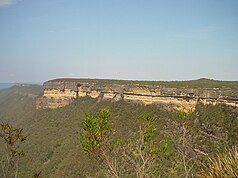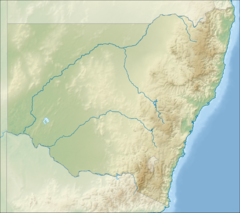Kanangra Boyd National Park
| Kanangra Boyd National Park | ||
|---|---|---|
| View from Echo Head to the Kanangra Walls | ||
|
|
||
| Location: | New South Wales , Australia | |
| Specialty: | Canyons, waterfalls | |
| Next city: | 30 km from Oberon | |
| Surface: | 686.6 km² | |
| Founding: | 3rd December 1969 | |
| Visitors: | 40,000 (1997) | |
The Kanangra Boyd National Park (English Kanangra Boyd National Park ) is a 686 km² national park in New South Wales , Australia , about 130 km west of Sydney . It is located in the area of the Blue Mountains, which was declared a World Heritage Site in 2000 , and adjoins the Blue Mountains National Park of the same name to the east .
The national park can be reached via the Great Western Highway , from which one branches off near Lithgow in a southerly direction to the famous Jenolan Caves . From there, a 5 km long gravel road leads into the park, which can also be used by vehicles without all-wheel drive. The closest town of Oberon is about 30 km west of the park.
landscape
Like the entire area of the Blue Mountains, the Kanangra Boyd National Park consists of a high plateau of soft sandstone , in which the rivers have carved themselves deeply over time. This is how the typical ravines and canyons, vertical rock faces and towers , were created along the edge of the Boyd Plateau . The best known are the Kanangra Wall , the Kanangra Falls , 180 m deep cascading waterfalls, and the Mount Cloudmaker .
There are several designated hiking trails in the national park, including the Lookout Walk , the easiest and also suitable for wheelchairs. It leads to two viewpoints. From the first one overlooks the Kanangra Gorge with Mount Cloudmaker behind it, from the second one has a good view of the upper part of the Kanangra Falls . The Waterfall Walk also branches off from here . It leads down into the gorge to a deep basin where the waterfalls end. The Plateau Walk eventually leads to the high plateau through the open woodland and heathland of Kanangra Tops .
Wildlife
The local fauna includes short-billed hedgehogs , platypus , giant pouch martens , bare-nosed wombats and dingoes, five species of kangaroo, including the rare brush-tailed rock kangaroo . Red-necked wallabies and swamp wallabies are most commonly observed. The Eastern Gray Giant Kangaroo is rarer and can be found mainly in the Boyd Plaetau area. Individual evidence is also available for the mountain kangaroo . In addition, numerous invasive animal species such as rabbits , red foxes , cats , goats , pigs and fallow deer are widespread in the national park, some of which have a negative impact on the ecosystem.
Web links
- Official site of the park (English)
- List of animals in the park (English)
Individual evidence
- ↑ NSW National Parks & Wildlife Service: The Greater Blue Mountains World Heritage Nomination (PDF; 5.9 MB), page 239. (English)
- ↑ Australia Easy Read - Road and 4WD Atlas . Hema Maps, Brisbane 2007, ISBN 978-1-86500-395-5 .
- ↑ a b c Official website of the park. (No longer available online.) DECCW , archived from the original on October 28, 2009 ; Retrieved April 20, 2010 (English). Info: The archive link was inserted automatically and has not yet been checked. Please check the original and archive link according to the instructions and then remove this notice.
- ^ A b Otmar Lind, Andrea Hiehues: Australia - The most beautiful national parks . Edgar Hoff Verlag, Rappweiler 1995, ISBN 3-923716-12-5 , p. 89 .
- ^ Department of Environment and Conservation (NSW): The Vertebrate Fauna of Kanangra-Boyd National Park. Project funded under the Central Directorate Parks and Wildlife Division Biodiversity Survey Priorities Program. (2004)





